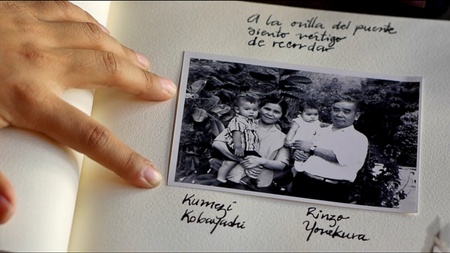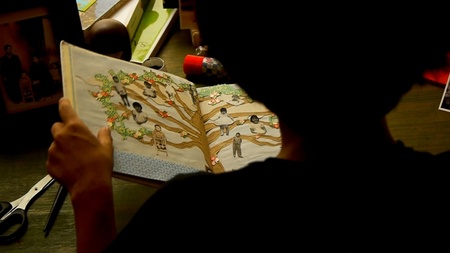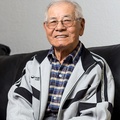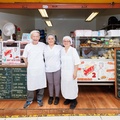Si tuviera que ser un dibujo sería Campanita. Pequeña, cara bonita, voz que canturrea cada palabra. Sí, Kaori Flores Yonekura tiene la gracilidad del hada más chiquita de Disney. Se nota en las fotos, al verla posar. “Últimamente me estoy sintiendo como ella, tantas emociones no caben en mí”, dice, como el ser alado que explota si tiene más de un sentimiento a la vez. Pero el mundo de Kaori es real: acaba de estrenar su primera película, un documental que la enfrentó con sus orígenes, la búsqueda de una memoria. Eso fue Nikkei, la obra que ahora la tiene a punto de explotar.

Kaori Flores Yonekura presentó su película en Perú, la puerta de entrada de sus abuelos a Sudamérica.
“Fue increíble ver que la gente entendía la película, ¡yo creí que solo lo haría mi familia!”.
Kaori es una cineasta venezolana que hace unos años empezó a preguntarse por qué se comportaba tan distinta a sus amigos. ¿Existiría algo más allá de lo aprendido donde se vive o se nace, similar a una memoria genética –con traumas heredados– que es más fuerte que uno? Ella dijo sí.
Al principio escribió sus dudas a modo de cuento, hasta que las hojas avanzaron y ya tenía un proyecto documental entre manos. Entonces se animó a desentrañar la historia de sus abuelos japoneses, los detalles de una migración que habían permanecido en el silencio.
Hacer Nikkei fue como armar un rompecabezas.
En su casa no se hablaba del pasado. Tal vez por eso en sus recuerdos su abuela ve películas con ella, juega, le da de comer. Y no habla. Nunca.
El resultado de su aventura se vio por primera vez en el Festival de Cine de Lima (agosto 2011) donde Kaori estuvo presente. El filme tuvo un efecto mágico y convirtió a la directora en un hada de carne y hueso para muchos nikkei. Recibió agradecimientos que ella hasta ahora no entiende (“¿por hacer una película?”); una niña le dijo que a partir de su obra tenía el punto de partida para formar su propia identidad; una señora le aseguró que viendo el documental se estaba reconciliando con su lado japonés porque a su familia le habían sucedido cosas similares.
* * *
Contar la vida de los abuelos migrantes era también hablar de otros miles de japoneses que partieron con anhelos de un mejor futuro. Y Kaori quiso entenderlos recorriendo los pasos que ellos siguieron antes de asentarse en Venezuela. Sabía que su abuelo Rinzo había nacido en Yamanashi y un día de 1921 salió de Yokohama rumbo al puerto del Callao, en Perú. Nueve décadas después su nieta haría el mismo recorrido pero esta vez documentando las imágenes con una cámara de alta definición.
Tras hallar un coproductor nikkei (“porque iba a ser difícil que me entendiera un no nikkei tal como yo pensaba”) y tener el financiamiento, Kaori se fue a Japón sin ninguna certeza. En Tokio la chica que de niña se reía tapándose la boca como las mujeres japonesas (sin que nadie le hubiese enseñado) quedó agobiada casi al punto del desmayo. Cerraba los ojos para descansar del estímulo visual y tres sonidos se apoderaban de su mente: los trenes, las máquinas que le decían qué hacer y el canto de los cuervos.
La convivencia de lo tradicional con la modernidad y las tribus urbanas pululando por las calles la hicieron pensar “noooo, ustedes están un poquito locos, esto es un poco extremo para mí”. De ahí no era.
Al llegar a Lima se le apagó el color, encontró un lugar que parecía de dos dimensiones, un sitio que en invierno no tiene sombras, y que parece flotar en gas de agua sin ningún horizonte.
“Me dije: ‘¡guau! ¡qué cambio!’, el japonés no se abraza, es muy difícil de comunicar con la palabra, pero se comunica a través de la estética. No sé cómo pudieron haber venido desde el otro lado del mundo para acá”.
No tardó en descubrir que el clima y el paisaje gris lo compensan con la comida, la mayor expresión cultural en Lima (y en todo Perú).
En la película la huida de sus abuelos Rinzo y Rosa con su primera hija en brazos, se muestra en animaciones, fotografías y mapas. Una forma amable de revivir un tiempo trágico.
En la sala de prensa del festival Kaori afirma que necesitaba ese choque cultural para imaginar lo que sintieron sus abuelos. Ya en Venezuela Kaori incorpora el contexto político de la época, la Segunda Guerra Mundial, los campos de concentración, el crecimiento del árbol familiar, y supo al fin que había evolucionado.
Nikkei explora la memoria con testimonios de sobrevivientes, lugares, información histórica, objetos, pero más aun con la bitácora de una búsqueda en primera persona, una voz interior que resuena y unifica. La cinta es su historia íntima.

El filme tuvo un efecto mágico. Una señora le aseguró a Kaori que viendo el documental se estaba reconciliando con su lado japonés porque a su familia le habían sucedido cosas similares. (Foto: Difusión Nikkei)
* * *
Lleva más de veinte minutos parada en la calle aguantando el frío. Es invierno en Lima. Kaori saldrá en las fotos enmarcada con ese cielo opaco que tanto la intriga. En este segundo viaje ha vuelto a probar que el cariño aquí entra por la boca. Lima, la puerta de entrada de sus abuelos a Latinoamérica, ese lugar que hoy más que nunca la define, la recibe con un festival lleno de aplausos.
“No somos japoneses, somos latinoamericanos con rasgos asiáticos. Quizá la película puede ayudar a ese tipo de reconocimiento”, afirma ya con un café en la mano.
Kaori tiene una nueva meta: quiere incentivar que las familias armen sus propios álbumes con fotografías, cartas y objetos que generen memoria. “En mi caso pasó y fue muy sanador”, dice la chica que se volvió hada con una película.

La cineasta venezolana reconstruye la historia de sus abuelos japoneses en Nikkei. (Foto: Difusión Nikkei)
Los locos Adams
- Kaori abrió una cuenta en Facebook donde ella y sus 36 primos fueron colgando fotos familiares que usó en el rodaje.
- Tenía un blog que le ayudaba a organizar su día a día. Fue hackeado. Ya no existe.
- La película demoró alrededor de dos años en hacerse.
- Grabaron más de 45 horas en total.
- Su coproductor es el peruano Hugo Shinki. Lo contactó por internet.
- Nikkei está inscrito en 25 festivales.
- En Perú será distribuido por el Grupo Chasqui.
- Pronto empezará a producir un DVD con comentarios de la película y escenas que se quedaron en el camino.
- Sus padres son artistas plásticos y sus hermanos diseñadores. En su familia son llamados los locos Adams (la mayoría son abogados).
* Este artículo se publica gracias al convenio entre la Asociación Peruano Japonesa (APJ) y el Proyecto Discover Nikkei. Artículo publicado originalmente en la revista Kaikan Nº 59, agosto 2011 y adaptado para Discover Nikkei.
© 2011 Asociación Peruano Japonesa; © 2011 Foto: Asociación Peruano Japonesa / Fernando Yeogusuku









